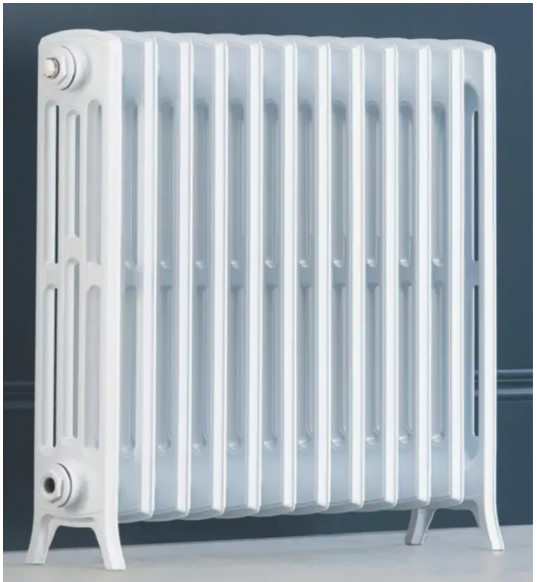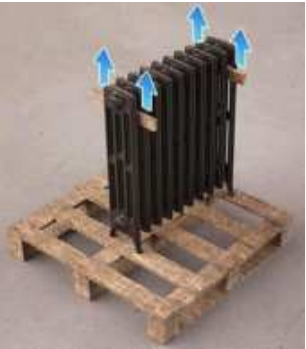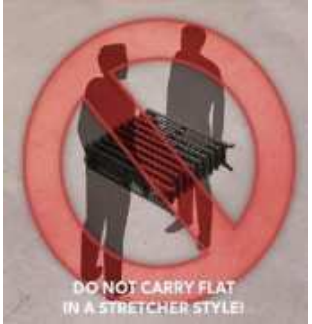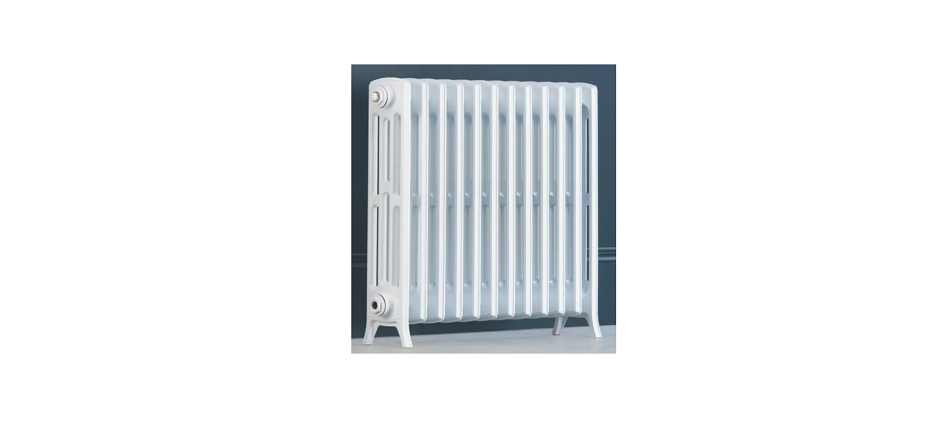Arroll 650mm x 1142mm White 5320BTU Edwardian Aluminium Bi-Metal Radiator

General Installation
Thank you for purchasing an Arroll radiator. The model supplied may vary slightly from the images shown, but for any further questions then please call +44 (0) 28 9036 5725 or visit www.arroll.co.uk.
We recommend that all products be purchased through a recognised Arroll stockiest, your nearest dealer can be found via our website. They should always be installed by an experienced installer who is a member of a recognised plumbing association. During Installation, extra care must be taken to avoid damaging the radiator or its finish.
To maintain the appearance of the radiator, please ensure that it is cleaned regularly using a clean soft damp cloth only. Abrasive cleaners or detergents must not be used as they may cause surface deterioration.
We provide a ten-year guarantee against faulty workmanship or materials (excluding paint finish and serviceable parts), providing they have been installed, cared for and used by our instructions.
For full warranty information please contact your dealer.
General Maintenance and Handling Guidelines
Delivery of your radiators is curbside delivery via contracted hauliers. The company is only required to deliver to the safest and most convenient accessible point they are not contracted to carry into a property or unload the pallet contents.
Cast iron radiators are VERY HEAVY so please ensure you have sufficient help to unload your order when it is delivered to you. It is important that the full length of the radiator is supported and the product is carried upright at all times.
A common cause of leakage is due to strain on the gasket seals caused by carrying the radiator flat without supporting the middle sections or dragging the radiator. The longer the radiator the greater the strain imposed on the water-tight seals.

Two strong pieces of wood can make good handles when inserted between the last 2 sections at either end. Cast iron radiators are for use on closed heating systems only, they are not suitable for installation on secondary HWS circuits.
Upon completion of the installation, the entire system must be thoroughly cleaned and flushed to remove debris flux residues etc. When a chemical cleanser is used it must be thoroughly flushed from the system.

Arroll recommends the use of the Fernox brand for power flushing and rust inhibitor, it is vital manufacturers’ guidelines are followed. After treatments, the water should be checked for a neutral PH between 7 – 8. Following this procedure, the system must be closed with a good eminence water treatment to prevent corrosion.
Due to the base material, heating systems should be annually checked and serviced (minimum 2 years) and inhibitors reintroduced. A record should be kept in case of a warranty claim.
System design, flushing and dosing must be by BS 5449, 1990, BS EN 12828:2003 and BS 7593.
We strongly discourage the use of a water softener on the heating system as this treatment can cause the gaskets to deteriorate.
It is important to note that failure to observe these requirements will render the manufacturing warranty on the products void. Corrosion inhibitors must be used according to the inhibitor manufacturer’s instructions and recommendations and should consider the particular metals within the system.
The most common cause of leaks is the over-tightening of the valve tails into the bottom bushes of the radiator. Over-tightening will crack the bush. When screwing the valve tail in to the bush turn it finger tight then using a spanner turn it until there is only moderate resistance.
Using a 4” (100mm) spanner it is difficult to over-tighten. It is easy to over-tighten and crack the bush with an 8” spanner.
All Arroll radiators come with the end bush’s hand tightened only.
This is to allow easy installation of valve tails. A thread sealant must be applied to the radiator end caps and to the valve tail threads to get a water-tight seal. LSX sealant available at all plumbers’ merchants is recommended.
PTFE tape is an acceptable alternative. We do not recommend the use of an 18” Stilton to tighten end caps. The torque from an 8” adjustable spanner is more than enough to create.
Instructions for Installation
- Remove the product carefully from the packaging, please take note that cast iron radiators are VERY HEAVY. A minimum of two people should undertake the method specified in the “General Handling” section of this booklet.
- Position the product in the desired location.
- Mark the wall for the location of the radiator stay bracket.
- Remove the product and drill the wall.
Note: Before drilling into the wall/floor ensure that there are no hidden electrical wires, cables or water supply pipes with the aid of an electronic detector. Radiator stays should be fixed into brick, concrete or a suitable anchor point. Plaster / Plasterboard is not suitable. - Insert the raw plug and screw in the radiator stay. Remove the front plate and adjust the rear plate accordingly.
- Apply a substantial amount of thread sealant (or a length of PTFE tape) to the end caps and the radiator valve (not supplied) thread and screw into the radiator. Take care not to over-tighten the valve as this is a common cause of leaks. Over-tightening can potentially crack the connecting bushes.
- Reposition the product and connect it to the pipework. Check carefully that all fittings are fully tightened.
- Re-attach the front plate of the radiator stay and secure it by tightening the nut.
- Fill the system with water and check carefully for leaks. It is advisable to have two people carry out this action so that one can control the water flow and the other can check for leaks.
- Provided no leaks are found the system should be flushed with a central heating cleanser to clean out any debris. (Arroll recommends using Fernox water treatments). The water must be tested to a neutral pH. 7 or 8. This process should be carried out to BS 5449, 1990, BS EN 12828:2003 and BS 7593 standards by a qualified fitter. Arroll strongly advises that water softeners should not be used in heating systems as this treatment can lead to gasket failures.
Note: Some base exchange softening, residues of cleaning agents and some industrial corrosion inhibitors designed only for use with ferric metals can damage seals please follow all instructions - Fill the system again just using hot water and gradually bring up to full heat to allow the cast to expand gradually. During this time check for leaks.
- Provided the system is deemed watertight add a central heating protector and allow the system to continue to run and once at full temperature release any trapped air using the bleed valve.
Note: Arroll radiators that have been painted will arrive with a touch-up paint pot to cover up any miscellaneous damage that might have occurred during installation and delivery. Please follow the paint safety sheet provided on request.
PLEASE NOTE:
Cast iron radiator products can be extremely heavy, so it is advisable to use two people when lifting/moving the product.
RADIATOR STAY BRACKETS MUST BE USED TO SECURE THE PRODUCT TO THE WALL WITHIN A SUITABLE ANCHOR POINT.
Arroll Surface Finish Guide
Part of the beauty of Cast Iron is the surface imperfections and that it does not have a smooth surface normally found on steel. Cast Iron will have natural blemishes such as pits and dimpling to differing degrees depending on the model.
This is caused during the pouring stage of casting and each section will have unique marks. Arroll will endeavour to remove or fill any deep pitting before painting except Primer orders. Pamplin cannot be removed as this occurs during the casting process.
Cleaning should only be carried out with a dry cloth or duster.
Below are explanations of the types of finish Arroll provide
- Full Polish: Each section is sandblasted to remove any surface primers then fettled and individually hand polished by Arroll experienced polishers. The radiator is then built, tested and lacquered. The lacquer is used to help preserve the finish however due to the nature of cast iron and the environments in which the radiator may be kept this will not guarantee against rust spots appearing. If rust spots do appear, light wire wool will remove the spots followed by touch-up lacquer available from Arroll on request (charges may apply). Polished finishes are not suitable for Humid atmospheres such as Bathrooms. It is also inadvisable to place wet clothes on polished radiators.
- Rustic Polish: Each section is coated with black primer and then fettled leaving black on any uneven surfaces, the section is then individually hand polished by Arroll experienced polishers. The radiator is then built, tested and lacquered. The lacquer is used to help preserve the finish however due to the nature of cast iron and the environments in which the radiator may be kept this will not guarantee against rust spots appearing. If rust spots do appear, light wire wool will remove the spots followed by touch-up lacquer available from Arroll on request (charges may apply). Polished finishes are not suitable for Humid atmospheres such as Bathrooms. It is also inadvisable to place wet clothes on polished radiators.
- Painted & Aged: AR Roll’s fully qualified in-house painting department provides a high-quality finish. Each section is tested, fettled and prepared for painting. The section is primed using a high-build primer and then painted to the required colour or colour match. Arroll uses a specially designed 2-pack paint product that gives a hard, durable surface. Scratches and chips in paint can easily be repaired with touch-up paints supplied with each order. However, if more is required please contact your retailer (charges may apply). Please follow the painting guide below.
- Highlighted/Burnished: Errol’s fully qualified in-house painting department provides a high-quality finish. Each section is tested fettled and prepared for painting. The section is painted in the primary colour then once dry painted with the secondary colour. While still wet the secondary colour is removed in specific areas exposing the primary colour. Arroll uses a specially designed 2-pack paint product that gives a hard, durable surface. Scratches and chips in paint can easily be repaired with touch-up paints supplied with each order. However, if more is required please contact your retailer (charges may apply). Please follow the painting guide below. With Black and Silver Burnish, treat the silver areas as polish (see above).
- Primer: This Is not a guaranteed finish. During the manufacturing process, Arroll only flashes the radiator with primer. Arroll does not prep the radiator for painting (rub down or remove major blemishes). The customer must understand this is not a sealed or finished product and that the customer is required to prepare and paint the radiator with the appropriate paints for the product.
Arroll Touch up paint Guide
Arroll uses a specialised 2K isocyanate Paint that requires an activator/ hardener to be added. Each painted order will come with 2 bottles; one with paint and one with an activator. Before opening please ensure all safety requirements are carried out.
- Well ventilated room
- Disposable gloves must be worn
- Appropriate painters mask
- Eye protection to be used. Avoid paint getting into the eyes. If this happens please seek medical help.
Pour the paint into a disposable cup and mix with hardener to a Ratio of 1-5. ONCE MIXED USE WITHIN 1 HOUR.\ Apply with a small brush to any areas that need touching up. It is vital to use the activator or the paint will not cure properly. Full safety information can be supplied upon request.
Paint Gloss Level Guide
- Full Gloss: 90% Gloss level high reflective surface finish
- Satin: 30% Gloss level mid-reflective surface finish
- Matt Finish: 10% Gloss level low reflective surface finish.
Note Matt will still have a sheen, but this should gradually dissipate
For More Manuals by Arroll, Visit LatestManuals


